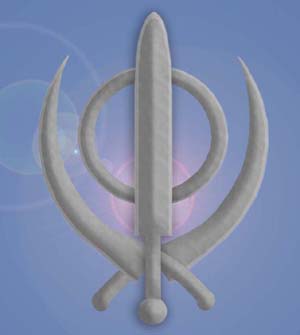Adi Shakti: Difference between revisions
From SikhiWiki
Jump to navigationJump to search
No edit summary |
No edit summary |
||
| Line 1: | Line 1: | ||
---- | ---- | ||
=='''Adi Shakti:''' | =='''Adi Shakti:''' Primal Power== | ||
It represents the Primal Feminine Creative Energy of the Universe | The Adi Shakti is a sikh symbol of 4 weapons. It represents the Primal Feminine Creative Energy of the Universe | ||
[[Image:kanda7.jpg|300px]] | |||
* The [[chakar]] (quoit) represents the infinite cycle of [[Karma|karma]] | * The [[chakar]] (quoit) represents the infinite cycle of [[Karma|karma]] | ||
* The [[khanda]] (double edged sword) represents [[dharma]] the path of faith in God. | * The [[khanda]] (double edged sword) represents [[dharma]] the path of faith in God, which is the only thing that can break the cycle of karma. | ||
* The [[Kirpan|kirpans]] (curved swords) represent [[miri]] and [[piri]]. | * The [[Kirpan|kirpans]] (curved swords) represent [[miri]] and [[piri]]. [[Miri Piri]] is a concept that means sikhs should have their priorities such that spiritual matters are equal to worldly ones. | ||
These are all weapons commonly used by sikh warriors in the 17th and 18th centuries. | -These are all weapons commonly used by sikh warriors in the 17th and 18th centuries. | ||
[[category:Glossary of Sikh Terms]] | [[category:Glossary of Sikh Terms]] | ||
Revision as of 17:25, 11 April 2005
Adi Shakti: Primal Power
The Adi Shakti is a sikh symbol of 4 weapons. It represents the Primal Feminine Creative Energy of the Universe
- The chakar (quoit) represents the infinite cycle of karma
- The khanda (double edged sword) represents dharma the path of faith in God, which is the only thing that can break the cycle of karma.
- The kirpans (curved swords) represent miri and piri. Miri Piri is a concept that means sikhs should have their priorities such that spiritual matters are equal to worldly ones.
-These are all weapons commonly used by sikh warriors in the 17th and 18th centuries.

